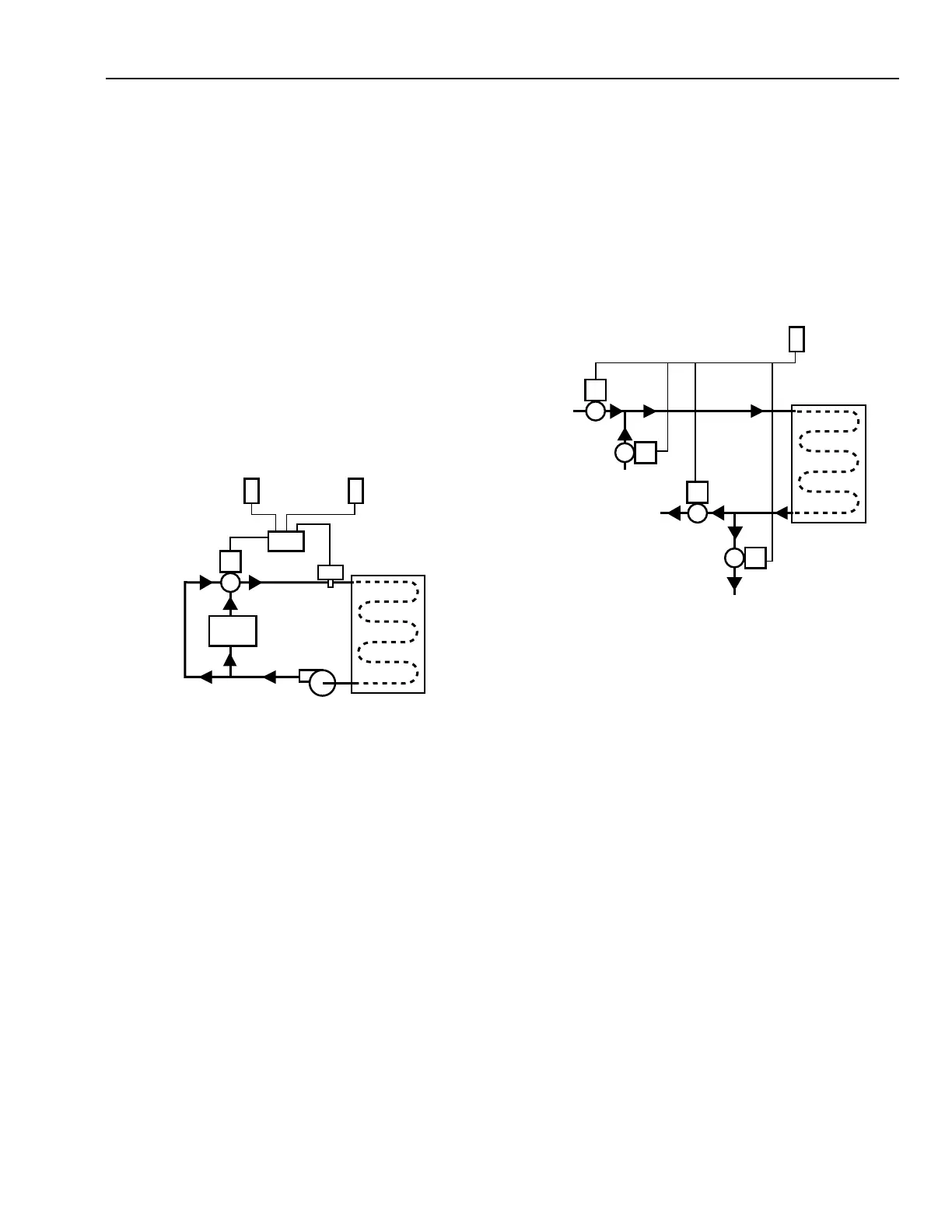INDIVIDUAL ROOM CONTROL APPLICATIONS
ENGINEERING MANUAL OF AUTOMATIC CONTROL
409
RADIANT PANELS
A radiant panel is a surf ace tha t tr ansfers 50 per cent or mor e
of its temper atur e to other surf aces by r adia tion. Radiant panels
may be used for hea ting or cooling of indi vidual spaces, or
may be used in conjunction with centr al fan systems. The panel
can be in a f loor, wall, or ceiling , and the surf ace temper atur e
can be maintained by electrical heating elements or by
circulating water or steam.
Contr ol for r adiant panel hea ting or cooling can be dif ficult.
Conventional space contr ol with a ther mostat ma y not be
appr opr iate because it is dif ficult, if not impossib le, to locate
the thermostat to sense the radiant heat. Because radiant heat
does not hea t the air , the ther mosta t must either see the r adiant
heat or sense the space temperature change caused by the
radia tion war ming the fur nitur e and occupants in the space .
The time lag in the second instance is too long for accurate
contr ol. Figur e 13 shows a hot w ater r adiant f loor hea ting panel
with an outdoor reset control system.
Fig. 13. Radiant Floor Heat System
with Outdoor Reset Control.
The space sensor , reset fr om the outdoor temper atur e, contr ols
the valve. As hot w ater cir cula tes thr ough the panel, hea t r adia tes
to war m objects in the space and space temper atur e rises. The
space sensor senses the increase in space temperature and
signals the contr oller to r eposition the v alve. The outdoor air
sensor pr ovides a r eset schedule to r aise the contr oller setpoint
as the outdoor temper atur e decr eases. To prevent tiles fr om
softening and concr ete fr om cr acking, radiant f loor panel surf ace
temper atur es should not e xceed 29.5°C. Where hot water
temper atur es may exceed 29.5°C, the high-limit sensor r esets
circulating water temper atur e.
Wall panels and ceiling panels can be contr olled dir ectly by
a r oom ther mosta t. Surf ace temper atur es should not e xceed
38°C for wall panels and 50 °C for ceiling panels. (T he actual
hot water temper atur e may be higher .)
Radiant heat panels that use electric resistance heating
elements ar e contr olled by a two-position ther mosta t. As the
space temper atur e dr ops below the ther mosta t setpoint and
differential, the ther mosta t closes a switch to allo w cur rent f low
to heat the elements.
When a radiant panel is used for cooling, the temperature of
the water cir culating thr ough the panel m ust be a t least
0.5 kelvins above the dew point temper atur e of the space to
pr event condensa tion on the panel.
A radiant panel may be used for both heating and cooling, as
shown in F igure 14. A heating/cooling panel uses a f our-pipe
system r egulated b y two-way valves on both suppl y and r etur n.
A call for hea t at the ther mosta t closes the chilled water suppl y
and r etur n por ts and modula tes hot w ater suppl y and r etur n. A
call for cooling closes the hot w ater suppl y and r etur n por ts
and modula tes chilled water suppl y and r etur n.
SPACE
TEMPERATURE
SENSOR
RADIANT PANEL
C3019
PUMP
OUTDOOR AIR
TEMPERATURE
SENSOR
THREE-WAY
MIXING
VALVE
CONTROLLER
HIGH-LIMIT
SENSOR
BOILER
Fig. 14. Heating/Cooling Radiant Panel.
Constant-v olume, constant-temper atur e centr al fan systems
can be combined with radiant-panel heating or cooling to satisfy
ventila tion r equir ements. Occupanc y schedules deter mine fan
operation. Room thermostats control the radiant panels to
maintain space temperature. Load anticipation is necessary
because of the high thermal inertia of this system. In general,
the thermostat setting should not be changed because of thermal
lag and the possibility of o vershoot. Ther mal la g in some r adiant
floors can be se veral hour s or mor e.
UNIT HEATERS
GENERAL
Unit heaters provide space heating for large open areas such
as building entrances, garages, workshops, warehouses, and
factories. Unit heaters are typically hung from the ceiling,
although cabinet versions are available. A fan forces air across
a coil containing hot water, steam, a warm-air heat exchanger,
or electric resistance elements. Warm-air units may be gas or
oil fired.
THERMOSTAT
RADIANT PANEL
C3020
CHILLED
WATER
SUPPLY
CHILLED
WATER
RETURN
HOT WATER
SUPPLY
HOT WATER
RETURN

